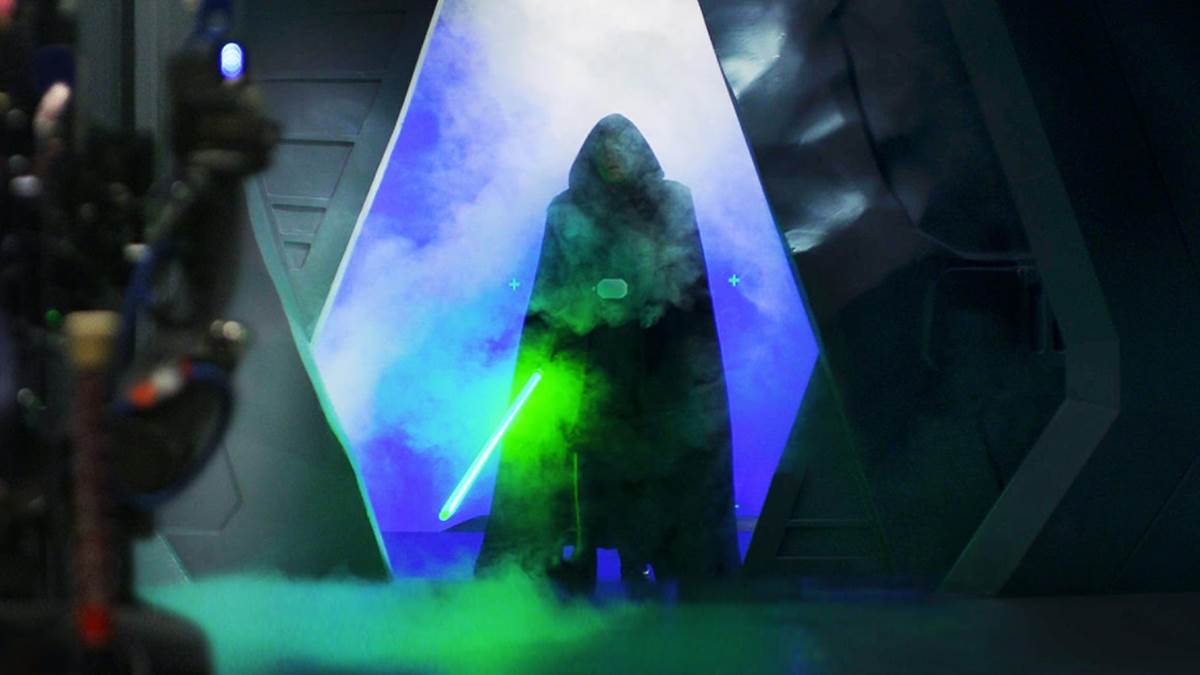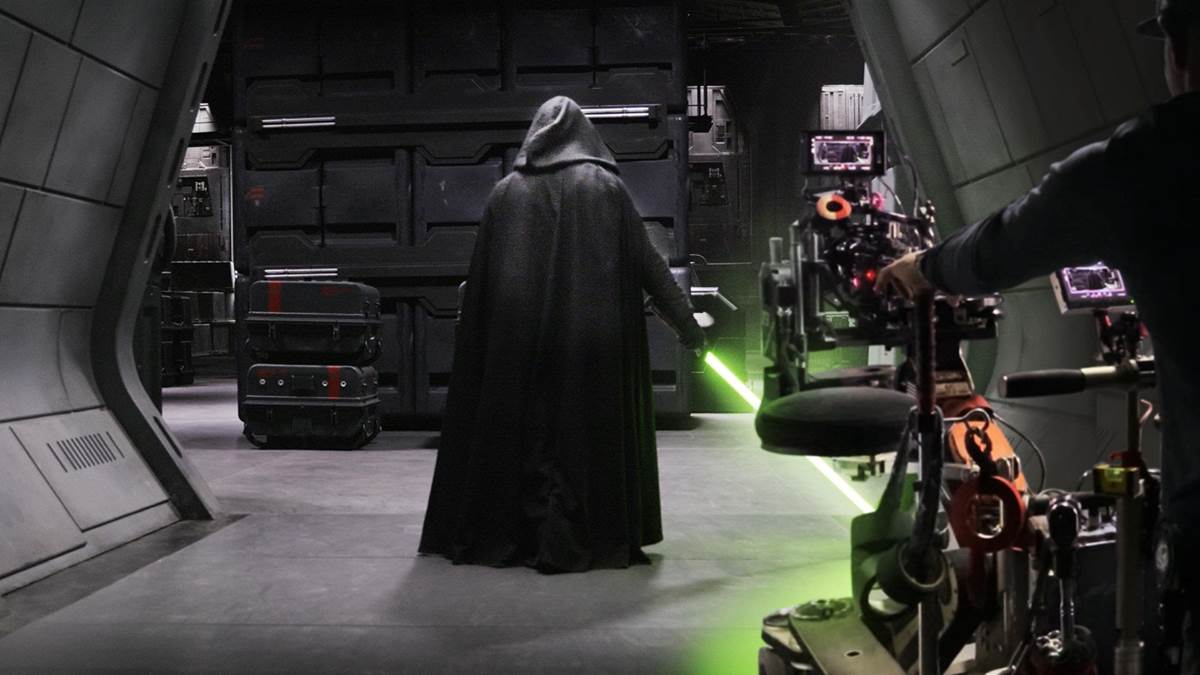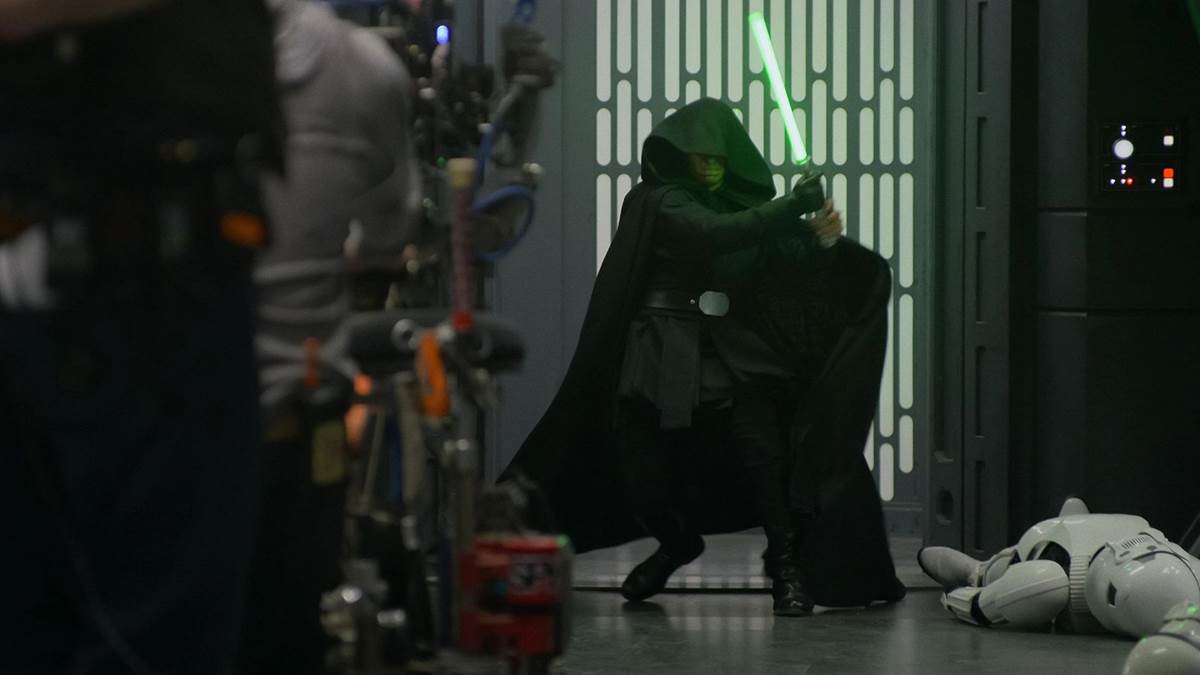Late last year, a new episode of Disney Gallery: The Mandalorian documented the making of the smash hit live-action Star Wars series’ second season, but stopped short of telling us just how its thrilling final scenes came together. Today, Disney+ has released a follow-up installment to the docuseries entitled “Making of Season 2 Finale” that at long last reveals how series creator Jon Favreau and his collaborators came together to facilitate the return of one of the franchise’s most enduring characters.
In the bullet-point list below, I’ve enumerated the most fascinating tidbits and factoids to come out of Disney Gallery: the Mandalorian’s “Making of Season 2 Finale.”
- The episode opens with Jon Favreau talking about the audience’s connection to Star Wars, especially if they grew up with the franchise from a young age. “People care deeply that it’s being handled correctly.”
- He credits Lucasfilm and Kathleen Kennedy for being supportive and encouraging in making the show.
- Director Peyton Reed says he loved the script for the second-season finale as soon as he read it.
- The Luke Skywalker cameo was written in the script as Jedi Master Plo Koon from the prequel trilogy, though this was just a smokescreen to throw people off the truth of what Favreau wanted to do.
- Visual Effects Supervisor Richard Bluff says no one was allowed to speak the name “Luke Skywalker” on set. We see footage of him talking on set and saying “Plo Koon” instead of “Luke Skywalker.”
- Executive Producer Dave Filoni says, “If there’s one person in the galaxy you’d be okay with taking Grogu from the Mandalorian, it’s gotta be Luke. It just felt right to both of us.”
- Reed was concerned about the responsibility of making Luke feel organic to the series.
- One of the first decisions they made was to have Mark Hamill return as the main performer behind Luke. Jon and Dave contacted him and invited him to the set. He did a voice for a droid in the cantina in season one.
- They showed Hamill the first episode of The Mandalorian before it aired, and he was impressed so they told him their plan of having him come back as Luke using a de-aging process. He thought about it but eventually decided it was a responsibility. “How could I say no?”
- Favreau and Reed went to Mark Hamill’s house with Luke’s wardrobe and a Grogu puppet for a camera-test photo shoot. Hamill read the script while the two filmmakers were waiting in the other room.
- “We knew that if we could pull this off, it would mean so much to so many people… especially to Mark– to let him come in and show Luke at this moment.”
- “Producers figure out ways to make things happen that are creatively exciting to the storytellers.” – Jon Favreau on Kathleen Kennedy
- ILM Visual Effects Supervisor John Knoll says that the expectation was to have the visual effects quality on The Mandalorian match that of the Star Wars feature films.
- Favreau lists off the possibilities of how they could approach bringing a younger Luke Skywalker to the screen: having a completely computer-generated version of the character, having an airbrush artist paint out wrinkles, or using Deepfake technology. He says they used a combination of all three.
- We see clips of footage of Luke Skywalker from the original trilogy that were used to scan into the computer for its “library” of Mark Hamill faces. Virtual Production Visualization Supervisor Landis Fields talks about how he fed information into the system, including Mark Hamill interview footage from that era.
- Reed talks about his experience using de-aging technology on the Ant-Man movies for Michael Douglas.
- A picture double named Max was used in addition to Mark Hamill to play Luke Skywalker on set. The casting process for this role was very secretive. Hamill and Max would observe each other doing the scenes so they could better match each other’s performances.
- After shooting on the Volume, Mark Hamill re-created his performance in a lighting rig called “the Egg,” which allowed ILM to get ultra high-resolution images of his face.
- While they were shooting Mark Hamill’s scenes with “the smallest possible team,” the rest of the crew was out in Simi Valley shooting Robert Rodriguez’s episode “The Tragedy.”
- Everyone was nervous about a potential leak coming out of the production, but Mark Hamill talked about how much experience he had with keeping secrets after filming the twist ending of The Empire Strikes Back.
- Favreau talked about the leaks concerning Rosario Dawson as Ahsoka Tano and Temuera Morrison as Boba Fett, but that their absolute priority was keeping Luke’s cameo a secret.
- There were even concept artwork and temporary visual effects created showing Plo Koon destroying the Dark Troopers instead of Luke.
- Hamill talks about how it was initially unfortunate that audiences got to see Luke’s journey from farm boy to Jedi, but never got to see his exploits as a Jedi. He jokingly compares it to seeing how James Bond got his “license to kill” but then never seeing him in action as an actual spy.
- Filoni talks about the discussions they had regarding the evolution of Luke’s sword-fighting technique post-Return of the Jedi. “His technique and Ahsoka’s technique should be very different.”
- Favreau talks about the decision to have Luke retain his costume from Jedi and the significance of his black robe as a symbol of moral ambiguity.
- The visual effects team had to choose between a variety of “looks” for Luke’s face and haircut as seen throughout the original trilogy. “Digital faces are the most difficult visual effect in the entire world, because every human is an expert in faces.”
- Favreau says Luke’s reveal is the first time in the season finale that we hear any music from the original trilogy. “Let’s never underestimate the importance of John Williams.”
- Reed talks about having shot a behind-the-scenes documentary about the making of Forrest Gump for director Robert Zemeckis, and how they were talking about the future of digital technologies back then.
- Favreau compares the use of the technology to “The Sorcerer’s Apprentice” in Disney’s Fantasia, and how it has the potential for both good and bad purposes. He talks about the possibility of using some sort of verification process in the future. “Part of our responsibility is to see how we can maximize the benefit while diminishing the downside.”
- The young Luke Skywalker voice is completely synthesized using an application called Respeecher.
- Favreau talks about how R2-D2 was his favorite character as a kid, and he was brought to tears by Artoo’s appearance on set with Mark Hamill. Filoni says they wanted the moment when Artoo meets Grogu to resemble when the droid met Wicket the Ewok in Return of the Jedi.
- Part of Artoo’s performance from Jedi was also used to create his scene in The Mandalorian.
- “For a generation of kids now, Grogu represents the same thing that Artoo and Yoda meant for me. It’s a very special character that we’ll take very good care of.” – Dave Filoni
- Hamill talks about how Grogu felt just as real to him as Yoda did in the original trilogy. “I’m the only one who has experience with this species.”
- Reed discusses the emotion of the separation between Mando and Grogu, comparing it to the ending of Steven Spielberg’s E.T.: The Extra-Terrestrial. “Let’s not be afraid of that emotion.”
- Favreau talks about the reactions from people on the set and fans on the internet, and sharing them with Mark Hamill, who reiterates his love for the fan community and their passion.
- Dave Filoni gives his speech about how Star Wars is intended to deliver a “good feeling.”
- The episode ends with Favreau ruminating on the collective experience of enjoying The Mandalorian together as a multigenerational family. “That’s what good television and good movies are all about. I’m very proud of that. It’s a great way to introduce the next generation to Star Wars.”
Disney Gallery: The Mandalorian – “Making of Season 2 Finale” is now streaming exclusively on Disney+.



